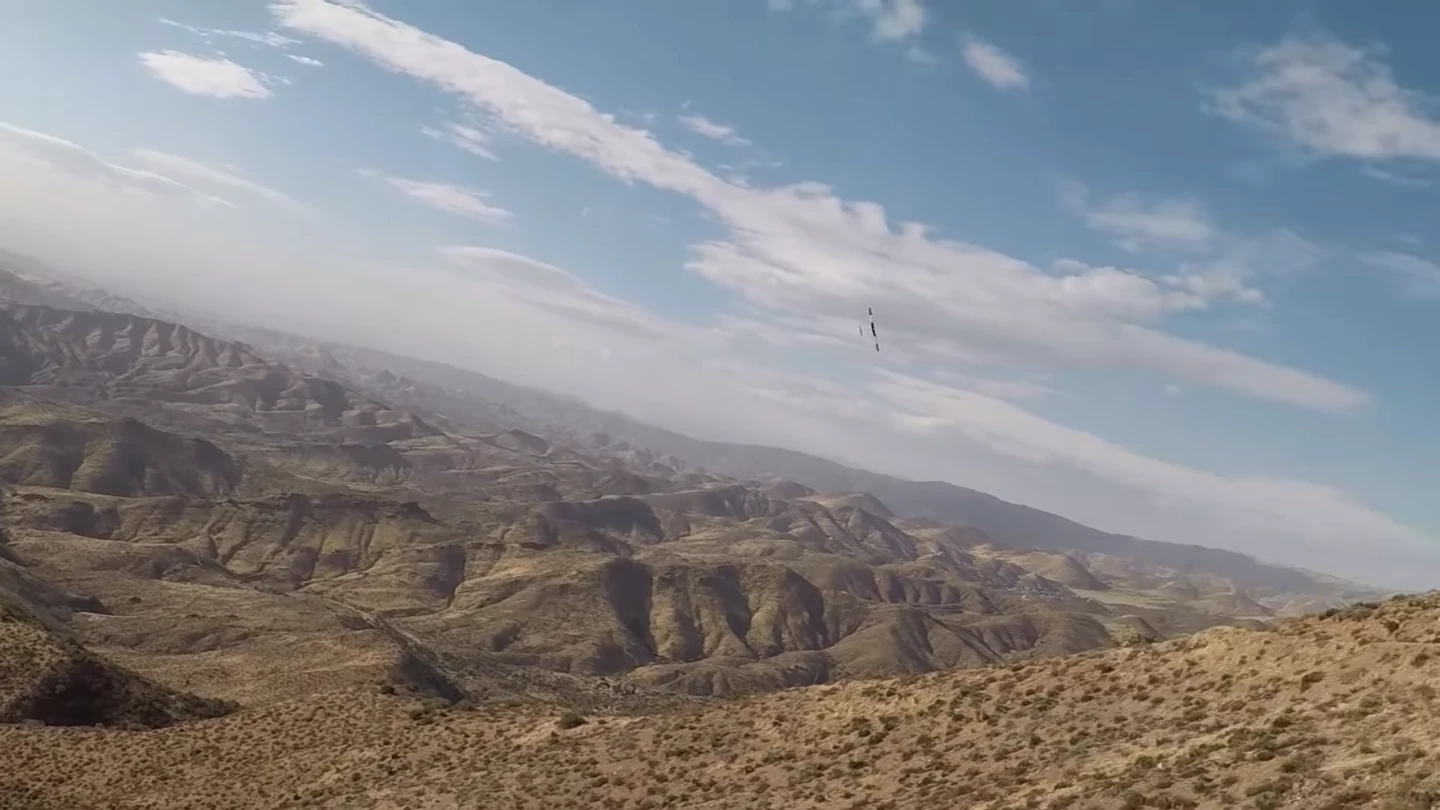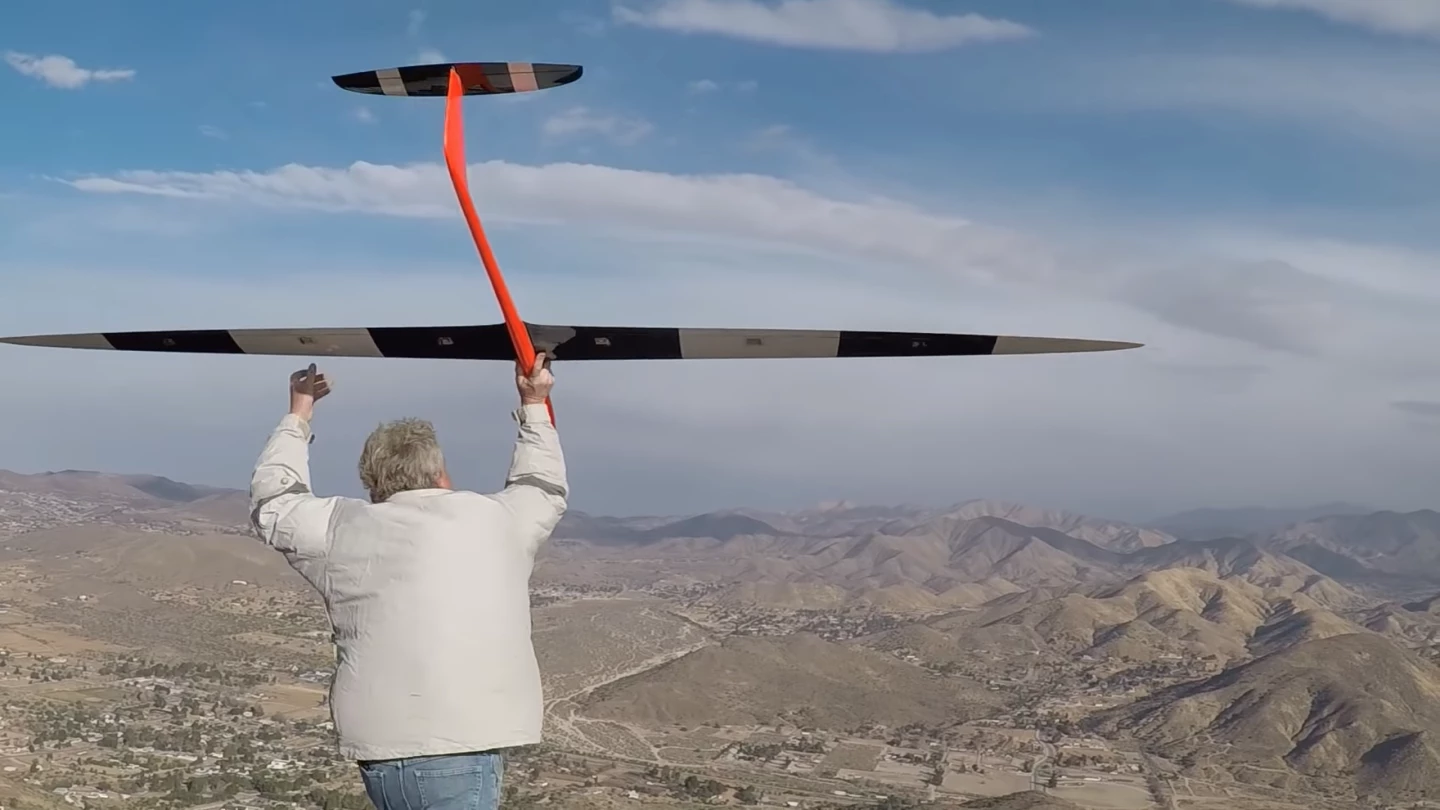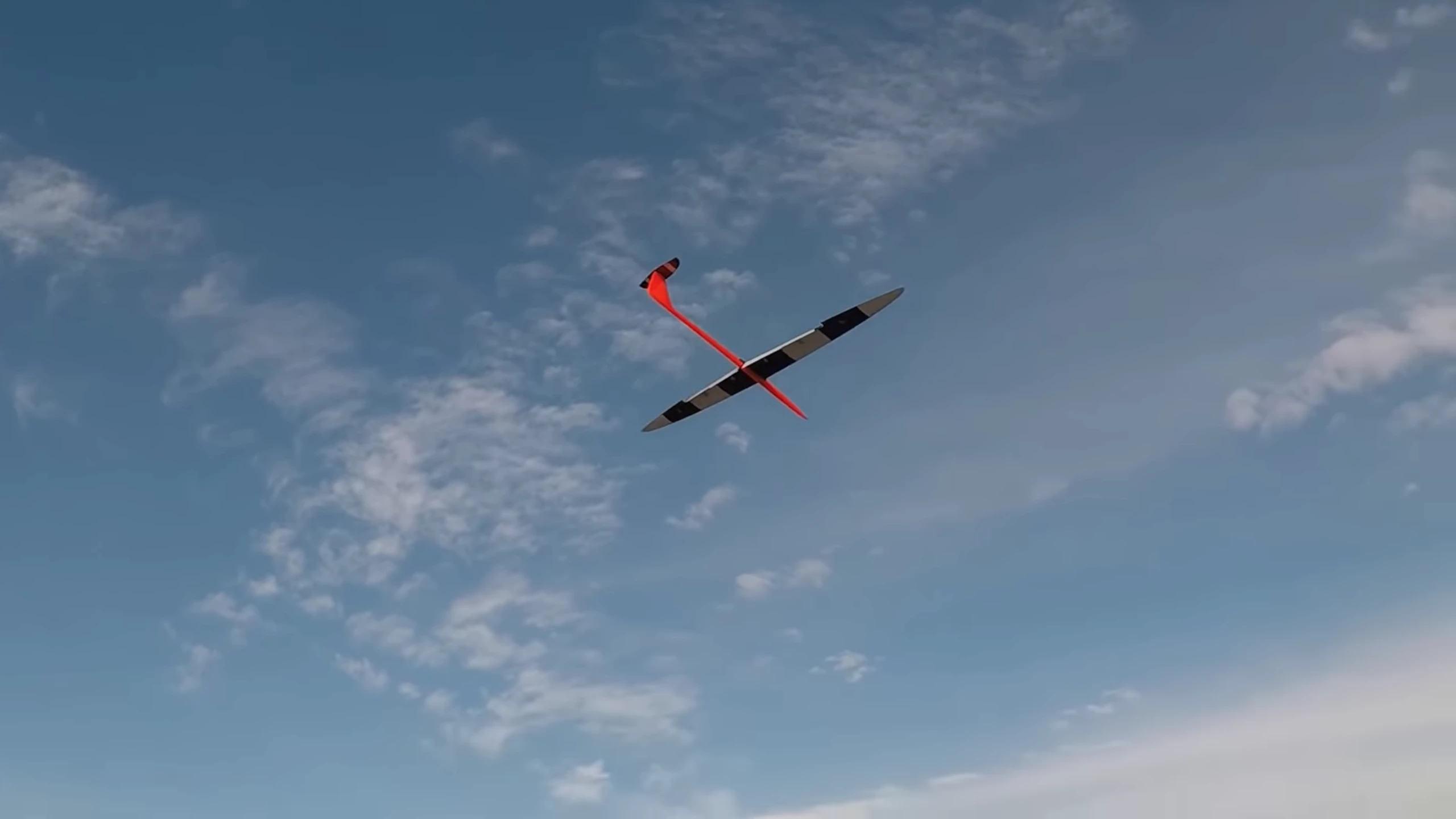No props, no jets, no rockets – California's Spencer Lisenby just broke the world speed record for remote controlled aircraft, taking an unpowered RC glider transonic at 548 mph (882 km/h) using nothing but the wind. Well, that and an incredible degree of skill in a highly dangerous technique called dynamic soaring. And while it's more or less an extreme hobby at the moment, he's got some very interesting plans for the technique and the technology behind it.
Wind accelerates like mad when it goes up a hill, and since the 1960s, "slope soaring" radio-controlled glider pilots have used that reliable source of energy to keep their aircraft flying pretty much indefinitely – as long as they take care to avoid the wild, plane-eating turbulence of the "shear layer" on the leeward side behind the hill where that fast-moving air begins interacting with the much slower air shielded behind the ridge.
But in the last 20 years, a group of intrepid RC glider fanatics has been experimenting and perfecting the art of plunging through that shear layer in a loop, using the extreme push of high winds to accelerate the gliders on the way down, and the still air under the shear layer as a way of returning most of the way upward without losing energy flying into a crazy headwind. The aircraft gains roughly the speed of the tailwind every time it goes down, and loses much less on the way back up, picking up energy and speed on every loop.
Not that these hobbyists invented the technique; the black-footed albatross has been using exactly this flight pattern for millennia, harnessing the wind speed differentials created by ocean swells to traverse long distances, in any direction, without expending any energy.
"I've even read that they can perform this maneuver in their sleep," Lisenby told an audience at the TNG Technology Tech Day back in 2017, "with their wing tip mere centimeters from moving water. We all aspire to the skills of the albatross. But they're usually trying to go somewhere. We're going for speed."
Dynamic soaring, or DS, might sound innocent enough as a title, but these extraordinary pilots are now taking unpowered gliders up to transonic speeds, perilously close to the ground. Continue tuning and optimizing that tilted loop between the high and low air speeds, and the glider gets faster and faster, until either the pilot messes up the loop, the aircraft disintegrates spectacularly under extreme G-loading or flutter stresses, or you reach an airspeed where drag finally limits your ability to go faster.

Lisenby is not just your average hobby flyer. He's absolutely obsessed with DS, and in addition to holding a swag of world records as a pilot, he's also a pioneering glider designer. Indeed, as a prototype designer at DSKinetic, he designs and develops all the huge gliders he flies, in conjunction with a local team, German aerodynamics experts and the University of Stuttgart.
Nothing off the shelf could come close to handling the constant 60-80 G-loadings these things experience, with spikes as high as 120 g as they whip around in their impossibly fast oval loops through turbulent air. For context, Formula One cars develop up to 6 g in the corners, and people tend to start passing out at around 8-9 g as the acceleration literally drains the blood from their brains.
The glider that just set the record is a 130-inch (3.3-m) DSKinetic Transonic DP, a taper-winged, heavily reinforced carbon beast with a design honed over many years to fly as fast as possible in dynamic soaring patterns without introducing the weird flight dynamics of swept wings. Theoretically, Lisenby says it should be capable of reaching 580 mph (933 km/h) in its current form.
On January 19th, 2021, Lisenby took advantage of a north-easterly wind over Parker Mountain, just north of Los Angeles, to notch his highest speed yet, a scarcely believable 548 mph. To put that in perspective, a 787 Dreamliner cruises at about 561 mph (903 km/h).
The feat was captured on the above video using a GoPro strapped to Lisenby's own forehead as he flew the thing. You'll thus have to forgive the quality of the cinematography – full-screen it on a large monitor and you'll get a sense of just how far and fast it's traveling, and how crazy the turning forces are as it rips a path through the air. Previous world record holder Bruce Tebo, who himself has broken the 500-mph (805-km/h) mark, was on hand to assist with the launch and operate the radar gun to track the glider's speed.
Why radar? "We decided on radar as the universal standard worldwide," Lisenby told the TNG conference. "Air speed has issues – the indicated airspeed has to be corrected for temperature, and it's hard for pilots to know the exact temperature and make those corrections. Consumer GPS loses its lock on satellites around 4 gs, we've been down that road. If anyone knows how to get their hands on military GPS, we should have a talk! Radar was the one standard thing – it doesn't depend on the wind speed, it's anchored to the ground, and it's easy for everyone across the world to compare their speeds with each other, apples to apples, fair comparison."
Watching Lisenby fly this thing is insane. Like watching a Formula One driver nailing inch-perfect laps at brain-frying speeds, it's hard to imagine any human having reflexes that fast, or any machine being capable of withstanding those forces. He's plunging that glider through turbulent air, under completely manual control in constantly-changing orientations, trying to maintain the optimal oval flight path for massive speed while instantaneously correcting for tiny roll motions that could plunge the thing into the ground at transonic speeds. One mistake, and this thing could easily turn a bystander into two neatly separated portions of bystander in the blink of an eye.

"Every time you go out there and fly faster than you have before, you get this feeling like you're in over your head, and your brain can't stay ahead of what's happening," he says. "It's a very difficult thing to keep up with. That's the human factor of dynamic soaring. The faster we go, the faster we have to think. The turbulence rolls your glider, and you have to make a choice which way to move the stick to maintain your heading. That takes almost half a second, and in that time, the plane's traveled more than 100 meters (328 ft) without even seeing an input from the pilot. At times, we're only five meters (16.4 ft) from the ground. You can see there's not much margin for error at these speeds!"
And yet it's that thrill that draws him to the sport. Asked if he's thought about automatic roll stabilization, he grimaces. "A friend of mine called Alan Ciccone in the US has been very active in this area. It works magnificently. The plane all but flies itself. You put it in the correct trajectory, you pull the elevator so it makes the right diameter circle, and you don't have to do much at all on the roll axis. I guess I'm an old-school guy, a bit of a purist. I actually savor the human aspect of soaring. We could get to a point where I could send my plane up a hill with some friends and just log in and find out how fast it went, but where's the fun in that? I value the research aspects of that, and I value the instrumentation for collecting data, but as a recreational activity it holds nothing for me. I love the adrenaline and the excitement of feeling the air. You learn by what the plane does to feel what it's encountering up there. It's really addictive, and I value that aspect of it."
This might be an odd kind of extreme adrenaline sport for the moment, but Lisenby thinks it's got a future as a long-range mode of flight for autonomous drones with minimal onboard energy storage.
"Go back to the albatross, the original inventor of DS," he says. "You can imagine a UAV which takes advantage of this flight pattern to traverse open expanses of ocean with no outside energy needed as long as the wind blows. If the wind isn't blowing, well, we could add solar panels to the top of the wing. The plane could land in the water and recharge its batteries, and when the wind picks back up, you'd use a propeller to take off again and begin your dynamic soaring circuit. It could go on indefinitely."

"Another concept," he continues, "is this idea of DSing the jetstream [narrow bands of strong wind up higher in altitude]. The jetstream has a vertical velocity gradient, you might have 100-mph (161-km/h) winds at 30,000 feet, but down at the ground level the wind velocity is zero. This velocity gradient, although it's not as abrupt as what we use on a ridge for RC gliders ... well, it's not enough to go fast with, but it's enough to sustain flight. You could conceivably drop a plane out of an aircraft at 30,000 feet, and have it come right back up, and keep on doing it as long as the jetstream remains active. Lehigh University's been working on that concept, it's called the Jetstreamer if you want to look into it further."
"Where can we go next? I've heard it's really windy on Mars," he laughs. "Looking at the surface of the planet, I notice it's filled with these craters. What's a crater but an ideal DS ridge, wrapped 360 degrees around? Any wind direction, you've got your DS ready to go!"
What a fascinating and extreme little slice of the RC gliding hobby – which itself is hardly a massive mainstream pursuit. To really geek out on the technology, as well as the huge passion, intricate knowledge and considerable humor Lisenby puts into dynamic soaring, I'd encourage you to watch that full hour-long TNG Technology Tech Day presentation. As somebody who's never seen an RC glider in real life, I found it riveting. It's hard not to get swept up in the energy of somebody so deeply into his niche.
Source: Spencer Lisenby via DroneDJ








